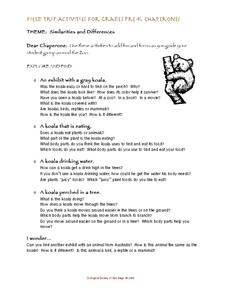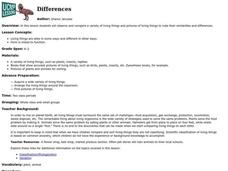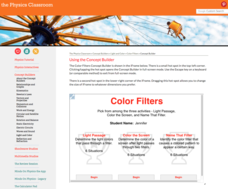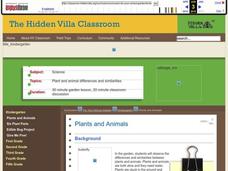American Chemical Society
Different Substances React Differently
Looks don't tell the whole story. Young experimenters explore reactions with substances that look similar. They observe the reactions that take place when combined with baking soda and use indicators to conclude they react differently...
Curated OER
Reptiles and Amphibians
Introduce your class to various reptiles and amphibians. They will meet and identify a representative from each of the four major reptile families, then learn about and discuss reptile characteristics. Next, they will identify and...
Curated OER
Angular Size and Similar Triangles
In this angular size and similar triangles worksheet, students use the properties of similar triangles and the ratios of sides to solve for unknowns in given diagrams.
Curated OER
How are Seeds Alike and Different?
Second graders examine the seeds in fresh fruit. In this seeds lesson, 2nd graders view different seeds and tell how they are alike and different. Students separate the seeds into groups according to their characteristics.
American Chemical Society
Comparing the Amount of Acid in Different Solutions
Upcoming chemists use chemical reactions to determine relative pH in two different acids. This is a terrific lesson for middle schoolers that can stand alone as a practice in precision and lab skills, or as part of the unit on chemical...
Curated OER
Similarities and Differences
Students complete pre-visit and post-visit activities about the koalas they see at the zoo. In this koalas lesson plan, students read books, and answer questions about the similarities and differences they see when they observe the koala...
Rhythm Rhyme Results
Whatʼs the Same and Whatʼs Different?
Learn about radiation, convection, and conduction with a multiple choice worksheet. Each question prompts kids to decide what is different about each form of heat energy transfer, and what is the same.
Virginia Department of Education
Cell Parts
What do a bird, an egg, a rabbit, and a toad all have in common? This fun-filled resource explains the similarities and differences between cells and how all cells are similar, yet all are different. Learners begin by depicting a...
Curated OER
Differences
Students observe and compare a variety of living things and pictures of living things to note their similarities and differences.
Physics Classroom
Color Filters
Filters provide amusing changes to images in applications other than just Instagram! High school pupils apply their knowledge of colored filters to three different interactive sets of puzzles. They identify light colors that pass through...
Curated OER
Human Genetics-- Thinking About Similarities And Differences
In this science worksheet, students investigate the differences in genetic traits of eyes, hair color and texture. Students answer 3 questions about themselves and draw a picture of their head.
Aquarium of the Pacific
Lego Molecules
Young scientists construct an understanding of molecular compounds in this hands-on science instructional activity. Using LEGO® to model the atoms of different elements, students build molecules based on the chemical formulas of common...
Curated OER
Plants and Animals
Students taste test the garden. In this Science instructional activity, students compare and contrast plants and animals needs. Students pick fruits and vegetables in the garden and discuss their observations.
Curated OER
How Are Plants Similar And Different?
Studetns create an index card database of different categories of plants such as bushes, trees, flowers, grasses and vegetables. They review the different parts of a plant and label pictures of plants on the database cards. They use the...
Curated OER
Penguins Around the World
Students investigate penguins. In this Science lesson, students compare and contrast penguins to flying birds. Students use a Venn diagram to illustrate the differences and similarities of penguins and flying birds.
NASA
Whip Up a Moon-Like Crater
The moon is famous for its craters, but they haven't always been there. Young learners experiment with materials to simulate the creation of moon craters. Pupils are able to see patterns in their materials that are similar to the...
National Science Teachers Association
Hop into Action
Young scientists find out what makes amphibians such unique and interesting animals in this simple life science lesson. After looking at pictures and discussing the characteristics of amphibians, learners complete a series of three Venn...
PBS
Why Do We Have Seasons?
Explore the reason for the seasons! An interactive lesson allows learners to explore the earth's rotation from the viewpoint of four cities at different latitudes. It provides descriptive information at eight points during the orbit...
Alabama Wildlife Federation
Leaf Chromatography
Pigmentation of leaves is important in plant processes. Scholars use chromatography to create a better picture of the pigmentation in an assortment of leaves. They share their results to make comparisons between different plant species.
NASA
S’COOL Cloud Identification Chart
If you've ever wondered why clouds sometimes look so different, look no further than a classroom poster about cloud identification. It features pictures of clouds at high, mid, and low levels of altitude, as well as the name of each and...
Curated OER
Ourselves: Similarities and Differences
In this comparison learning exercise, students draw a picture of themselves. They find similarities and differences in attributes such as eye color with other people. Worksheet is written in British English.
Curated OER
DNA and Individual Differences
Middle schoolers list differences between DNA-related terms and create a simple DNA circle map. They order terms including human body, organ, tissue, cell, nucleus, etc. from largest to smallest. They discuss differences and...
Curated OER
Colors of Wildlife
Students observe wildlife animals. In this wildlife lesson, students cut out three different animals from a wildlife magazine. Then they compare the animals, verbally stating their similarities and differences.
NOAA
Mud is Mud...or is it?
We know that the type of soil varies by location, but does the seafloor sediment also vary, or is it all the same? Scholars compare photos of the seafloor from two different locations: the Savannah Scarp and the Charleston Bump. Through...

























